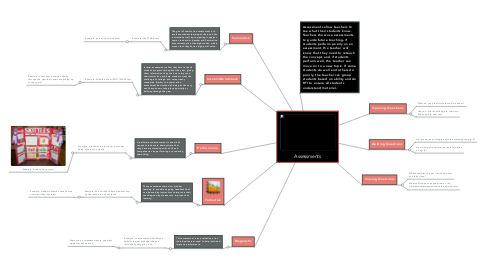Assessments
by Sarah Giles


1. Assessments allow teachers to see what their students know. Teachers show use assessments to guide future teaching- if students perform poorly on an assessment, the teacher will know that they need to reteach the concept, and if students perform well, the teacher can move on to a new topic. If some students do well and others do poorly, the teacher can group students based on ability and do RTI to ensure all students understand material.
2. Summative
2.1. The goal of summative assessment is to evaluate student learning at the end of an instructional unit by comparing it against some standard or benchmark. Summative assessments are often high stakes, which means that they have a high point value.
2.1.1. Example: the STAAR test
2.1.1.1. Example: an end of course exam
3. Formative
3.1. These assessments monitor student learning to provide ongoing feedback that can be used by instructors to improve their teaching and by students to improve their learning.
3.1.1. Example: an exit ticket where students sum up the lesson in one sentence
3.1.1.1. Example: students draw a concept map over what they just read
4. Interim/Benchmark
4.1. Interim assessments allow teachers to check student progress throughout the year, giving them information they can use to improve their instruction and help students meet the challenge of college- and career-ready standards. Similar to a summative assessment but instead of being at the very end these exams take place quarterly or halfway through the year.
4.1.1. Example: Middle of Year (MOY) MAPS test
4.1.1.1. Example: a test administered halfway through the year that covers everything up to that point
5. Performance
5.1. A performance assessment is one which requires students to demonstrate that they have mastered specific skills and competencies by performing or producing something.
5.1.1. Example: a research project over a concept being covered in science
5.1.1.1. Example: Science Fair project
6. Diagnostic
6.1. This assessment is an evaluation of an individual learner used to help individual improve performance.
6.1.1. Example: an assessment that helps a specific learner with what they are individually struggling with
6.1.1.1. Example: a pre-assessment to see what students already know

